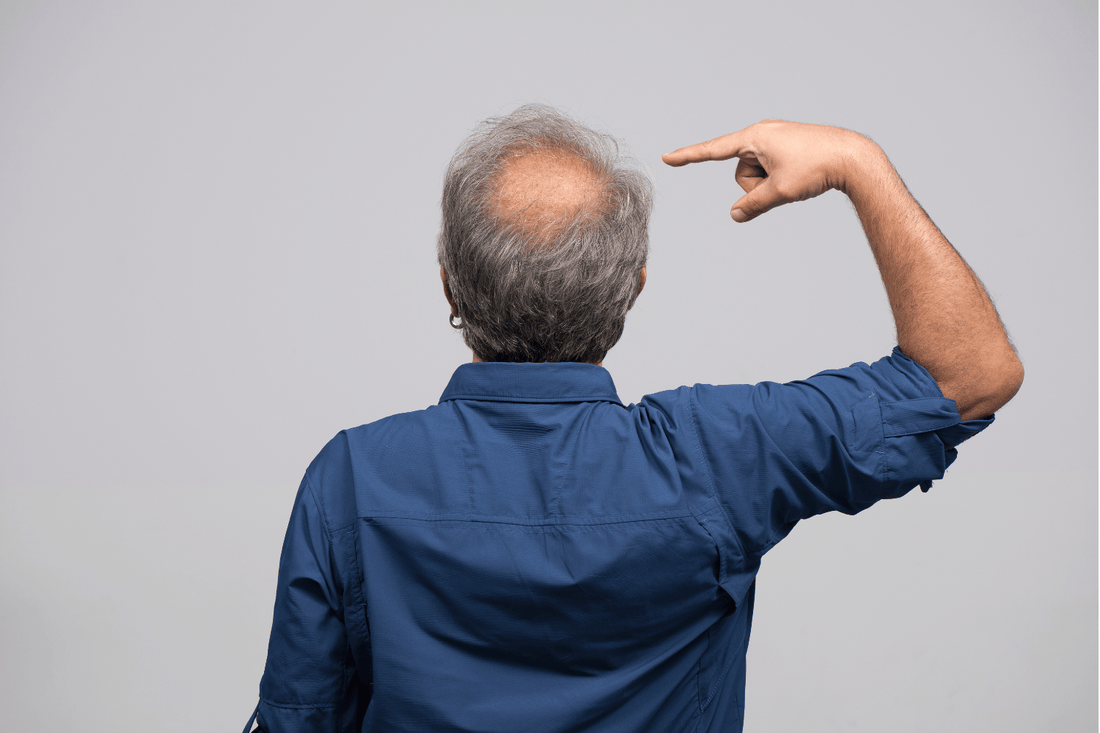Noticing thinning or balding at the crown of your head can be a particularly alarming moment. This is a type of hair loss that comes as a shock for some people, often first being pointed out by a friend or only becoming apparent in photographs. For men who have closely followed a gradual recession in their hairline over time, a balding crown marks a further stage of hair loss that can be difficult to accept. For women, hair loss often starts along the central parting and crown thinning can be an upsetting first sign.
Fortunately there are options available for both men and women with a balding or thinning crown. This article looks at how crown balding tends to develop and explores some of the ways back to a thicker, fuller head of hair.
What causes balding at the crown?
While patterns of baldness vary from individual to individual, it is often the case that men experience crown balding as one of the later stages of hair loss while women often experience thinning on the top or back of their head from the onset. There are multiple possible causes of hair loss at the crown, ranging from stress and hormones to injury and even botched hair transplants. Below we are primarily focused on the typical stages of male and female pattern baldness, which are the most common causes of hair loss in adults.
Female crown thinning
Androgenetic alopecia in women, often referred to as female pattern baldness, is more common than many think and its prevalence increases with age. Approximately 12% of women in their twenties experience female pattern baldness, a figure which rises to over 50% for women over the age of 80.
Patterned baldness can present itself in varied ways and multiple classification systems have been proposed to allow grading or to identify typical stages. The Ludwig scale is the most commonly used system for female hair loss. This three-grade system clearly shows crown thinning as the primary way women experience androgenetic alopecia. Each of the grades essentially involves a more extreme version of crown thinning, with Grade III presenting as full balding at the crown.
The Ludwig scale highlights retention of the hairline on the forehead, but this will not always be the case. Some women actually experience male pattern baldness, and others see a triangular pattern of thinning, with the most significant loss occurring at the vertex (just in front of the crown).
Crown balding in men
Male pattern baldness is even more common, affecting up to 50% of Caucasian men by middle age and almost all Caucasian men by old age. In contrast to the pattern most frequently seen in female hair loss, most men hold on to the hair at the back of their head for longer. While less common, some men experience vertex balding, developing a bald spot near the crown while retaining a fixed frontal hairline.
There are again numerous classification systems for patterned balding in men. The most commonly used is the Hamilton-Norwood system, which records quite a range of progressions and experiences of balding. The system shows that some men will see quite significant balding at the front of the head before seeing any bald spot on the crown, whereas others will experience crown baldness from the outset of their hair loss.
Can you regrow hair on the crown?
The short answer is yes, there are effective methods for regrowing hair on the crown. The suitability, side effects and practical considerations of each option will weigh differently for each individual.
How do you fix a balding crown?
Minoxidil & Finasteride
Minoxidil and finasteride are both very commonly prescribed products aiming to address hair loss.
Minoxidil was introduced in the 70s as a treatment for refractory hypertension. Excessive hair growth was observed as a common side effect, and the drug has subsequently been used in oral and topical forms to promote hair growth. Minoxidil requires a minimum of 3-6 months of use for visible results and to maintain the impact on hair growth the drug must be taken indefinitely. One of the more commonly reported side effects, hair shedding can occur upon starting to take minoxidil. We’ve compared these two options in depth in a previous article: minoxidil vs ProCelinyl.
Finasteride was developed to treat male prostates, but was later found to also be useful in blocking the creation of DHT in men. However, it has been shown to have some undesirable side effects.
ProCelinyl
Topical serums can be of particular use when tackling crown balding because they can be applied directly to the crown, targeting the specific area of concern.
ProCelinyl is an ingredient that directly targets hair follicle health, jumpstarting dormant roots to support the appearance of thicker, fuller hair. To discover ProCelinyl, Revela’s scientists used a cutting-edge AI engine to scan millions of potential ingredients to find a targeted hair loss solution that is both safe and effective. Consistent use can bring significant improvement to the appearance of the crown in just 6-8 weeks.
Hair transplant - crown area
More common among men experiencing a balding crown, hair transplants provide an option of a different nature. The process involves taking hairs from another part of the scalp or a separate part of the body, and grafting them onto the crown. A costly option, hair transplants are invasive and not without risk.
Hair camouflage
Another option is to attempt to conceal a thinning or balding crown with some form of hair camouflage. Options range from hairpieces, hairstyling products and hair thickening fibers, through to a tattoo-like process called scalp micropigmentation. While these options can be affordable, convenient and appealing, they do not address the underlying cause of crown hair loss.





